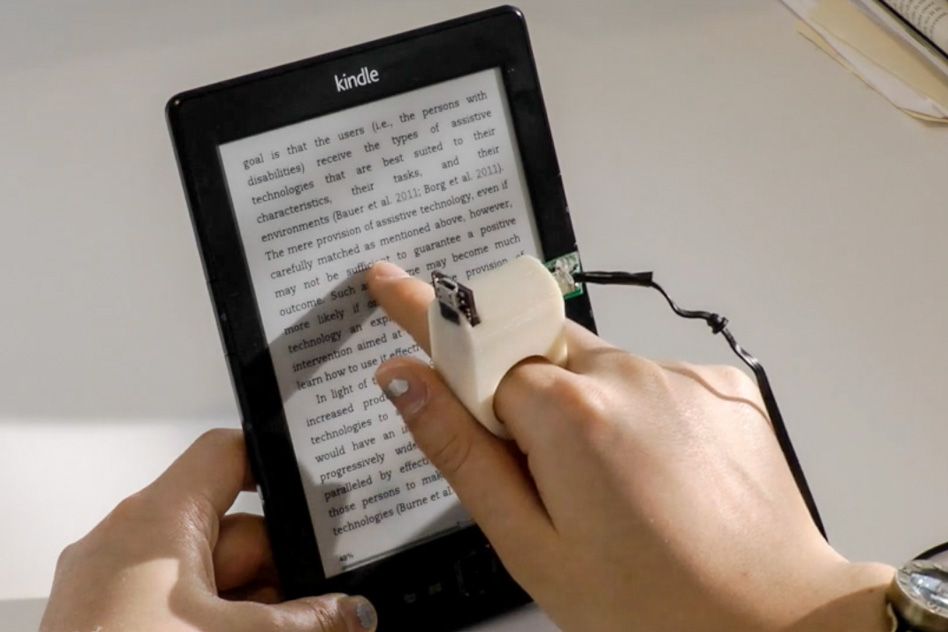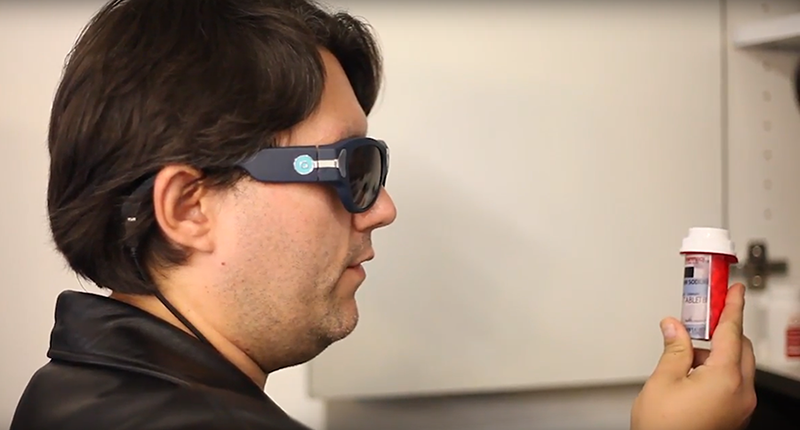Enhance Accessibility with Braille Tools and Notetakers
Enhance Accessibility with Braille Tools and Notetakers
Blog Article
Discover Cutting-edge Tools Developed for the Aesthetically Impaired
The advancement of innovative tools for the aesthetically impaired stands for a considerable improvement in ease of access and independence. Technologies such as clever glasses with AI capacities and mobile applications designed to offer auditory descriptions are improving everyday experiences for customers. Additionally, wearable gadgets that utilize haptic responses improve environmental recognition, while contemporary Braille advancements supply brand-new methods to involve with message. As these tools remain to develop, their effect on the lives of those with visual problems increases important questions about the future of inclusivity and autonomy in different facets of life. What exists in advance in this technological landscape?
Smart Glasses for Navigating

Smart glasses created for navigation are revolutionizing the means visually impaired people communicate with their environment. These sophisticated tools use a mix of electronic camera innovation, expert system, and auditory feedback to supply real-time information about environments. By employing challenge detection systems, wise glasses can alert individuals to possible risks, making it possible for safer flexibility in both strange and acquainted settings.
The integration of GPS technology additionally enhances navigation capacities, permitting individuals to obtain auditory directions as they move. This hands-free strategy not just fosters independence however additionally empowers visually damaged people to navigate metropolitan landscapes with enhanced self-confidence. Furthermore, numerous smart glasses are outfitted with features that determine spots and road indications, providing contextual info that enhances the user experience.
In addition, the growth of these tools is constantly advancing, with companies working to enhance the accuracy of object recognition and broaden the variety of navigational attributes. As smart glasses end up being much more inexpensive and available, they hold the possible to dramatically change day-to-day live for visually impaired customers. Eventually, these innovative devices represent an essential step towards inclusivity, offering enhanced movement and a better feeling of autonomy for people browsing the world around them.

Mobile Apps for Daily Living
How can mobile applications improve the every day lives of aesthetically impaired individuals? Mobile applications are transforming the way aesthetically damaged individuals browse their environments, take care of everyday tasks, and access details. These applications give important support via various functionalities, cultivating self-reliance and enhancing high quality of life.
Numerous innovative mobile apps are created especially for day-to-day living. Applications like Be My Eyes attach visually damaged individuals with sighted volunteers using video telephone calls, permitting them to obtain real-time assistance with jobs such as reading labels or browsing unknown areas. Likewise, Seeing AI, established by Microsoft, utilizes artificial knowledge to describe environments, checked out text, and determine things, properly transforming a smartphone into a powerful device for daily support.
In addition, navigation applications customized for the visually impaired, such as Aira and BlindSquare, use audio-based instructions and ecological information, enabling individuals to traverse their environments securely and confidently. Beyond navigation and prompt assistance, mobile apps likewise support company and task monitoring, with functions that help individuals establish reminders, produce order of business, and track appointments. In recap, mobile applications act as important sources, empowering visually damaged individuals to lead even more independent and fulfilling lives.
Wearable Technologies for Help
Empowerment with technology is increasingly apparent in the realm of wearable gadgets made to help visually impaired people. These innovative tools incorporate perfectly right into day-to-day life, enhancing navigating and giving necessary comments to customers. As an example, wise glasses outfitted with cameras can read and acknowledge faces message out loud, enabling customers to engage more confidently in social and specialist settings.
One more remarkable advancement is making use of haptic responses systems in wearable gadgets. These systems utilize resonances or other tactile signals to share information about the customer's setting, such as barriers or modifications in terrain, improving mobility and safety. Wearable technologies additionally consist of wristbands that attach to mobile phones, alerting customers to notices via subtle resonances, therefore boosting connectivity without reliance on visual signs.
As these modern technologies continue to evolve, they are not only enhancing self-reliance for visually impaired people however additionally fostering a better sense of incorporation in culture. By connecting the gap between obstacles faced in everyday living and the possibility for freedom, wearable innovations function as crucial devices in the mission for equal rights and empowerment for those with aesthetic impairments.
Sound Summary Devices
Sound description tools play a vital function in improving ease of access for visually damaged people, providing them with the capacity to involve with visual media. Speech-to-text devices for low vision. These tools supply narrated summaries of key visual components in films, tv programs, and live efficiencies, guaranteeing that individuals can completely comprehend the context and emotions conveyed through visuals
Sound summary can be integrated into numerous platforms, try this web-site consisting of streaming services, movie theater screenings, and live movie theater. Numerous prominent streaming solutions currently consist of audio summary as an availability function, enabling visitors to choose it conveniently. In enhancement to traditional media, specialized applications also exist, offering audio descriptions for art exhibitions, museums, and other cultural events.
The efficiency of audio summary rests on the skill of the narrators, who have to convey visual information succinctly without interfering with the original audio. Technologies in this field are also paving the way for even more individualized experiences, where users can readjust the degree of information and pacing according to their preferences.
Braille Innovations and Instruments
Braille advancements and devices have actually significantly changed the means visually impaired people interact with text and info. Modern innovations have actually caused the development of versatile tools that improve literacy and self-reliance amongst users. Especially, Braille display innovations have actually evolved, permitting vibrant analysis experiences. These gadgets transform electronic message into Braille, allowing customers to access a huge array of info on tablets, computer systems, i loved this and smart devices.
Furthermore, portable Braille notetakers incorporate standard Braille input with modern capabilities, facilitating note-taking, organizing, and document editing and enhancing on the move. Screen readers for the blind. These small devices usually include text-to-speech capabilities, linking the gap in between Braille and acoustic details
On top of that, ingenious Braille printers have arised, enabling users to produce Braille tags, papers, and academic materials effectively. This ease of access cultivates greater participation in instructional and professional settings, eventually advertising inclusivity.
In addition, research right into wise Braille technologies remains to increase. Tools that integrate expert system are being discovered to offer real-time navigating assistance and contextual information, boosting the user experience in varied settings. Generally, these innovations show a commitment to empowering aesthetically impaired people with modern technology, ensuring they can conveniently access and engage with the globe around them.

Conclusion
The innovation of ingenious tools for the visually damaged substantially boosts freedom and lifestyle. Smart glasses, mobile applications, wearable innovations, audio description devices, and Braille developments jointly equip individuals by providing necessary navigation assistance, environmental awareness, and improved analysis experiences. These innovations not only foster greater incorporation however also advertise my company freedom in day-to-day activities, ultimately adding to a more available and equitable society for aesthetically impaired people. Continued development in this field holds promise for more enhancements.
As smart glasses come to be more obtainable and budget friendly, they hold the possible to significantly transform day-to-day life for visually damaged users. Mobile apps are reinventing the means aesthetically damaged users navigate their atmospheres, take care of daily tasks, and access information. Apps like Be My Eyes link aesthetically damaged customers with sighted volunteers via video phone calls, allowing them to receive real-time support with tasks such as reading tags or navigating unfamiliar spaces.Furthermore, navigating apps tailored for the aesthetically damaged, such as Aira and BlindSquare, supply audio-based directions and environmental information, enabling users to traverse their surroundings safely and with confidence.The development of innovative tools for the aesthetically damaged significantly enhances self-reliance and high quality of life.
Report this page